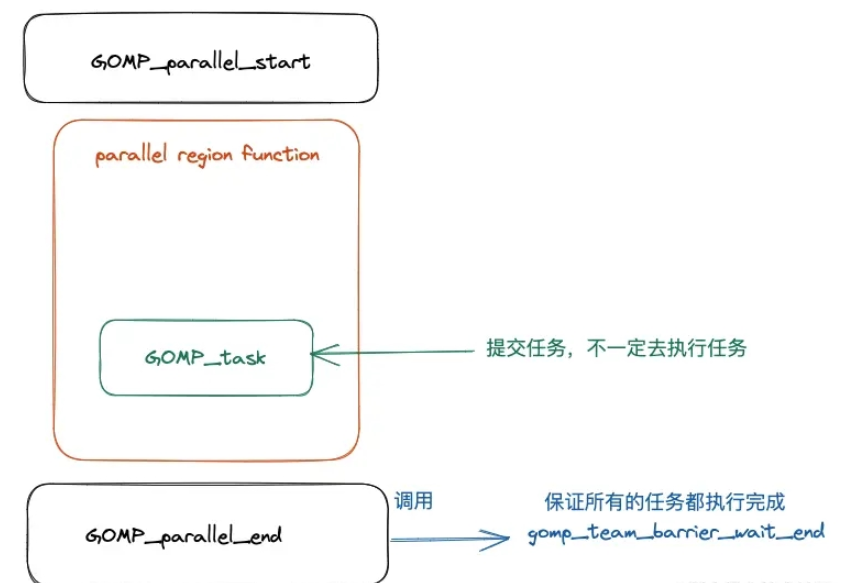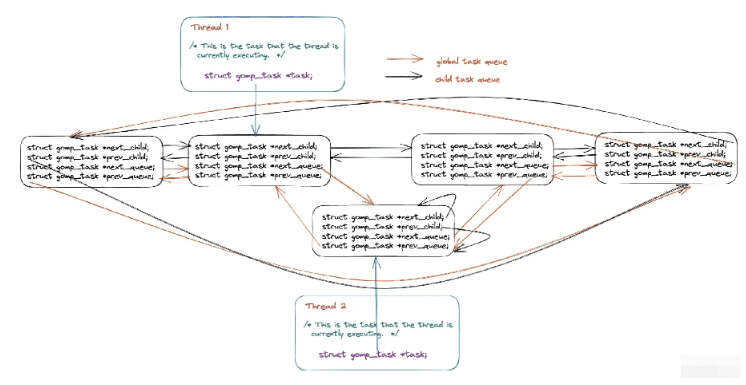您好,登錄后才能下訂單哦!
您好,登錄后才能下訂單哦!
本篇內容主要講解“OpenMP task construct實現原理源碼分析”,感興趣的朋友不妨來看看。本文介紹的方法操作簡單快捷,實用性強。下面就讓小編來帶大家學習“OpenMP task construct實現原理源碼分析”吧!
在本小節當中主要給大家分析一下編譯器將 openmp 的 task construct 編譯成什么樣子,下面是一個 OpenMP 的 task 程序例子:
#include <stdio.h>
#include <omp.h>
int main()
{
#pragma omp parallel num_threads(4) default(none)
{
#pragma omp task default(none)
{
printf("Hello World from tid = %d\n", omp_get_thread_num());
}
}
return 0;
}首先先捋一下整個程序被編譯之后的執行流程,經過前面的文章的學習,我們已經知道了并行域當中的代碼會被編譯器編譯成一個函數,關于這一點我們已經在前面的很多文章當中已經討論過了,就不再進行復述。事實上 task construct 和 parallel construct 一樣,task construct 也會被編譯成一個函數,同樣的這個函數也會被作為一個參數傳遞給 OpenMP 內部,被傳遞的這個函數可能被立即執行,也可能在函數 GOMP_parallel_end 被調用后,在到達同步點之前執行被執行(線程在到達并行域的同步點之前需要保證所有的任務都被執行完成)。
整個過程大致如下圖所示:

上面的 OpenMP task 程序對應的反匯編程序如下所示:
00000000004008ad <main>: 4008ad: 55 push %rbp 4008ae: 48 89 e5 mov %rsp,%rbp 4008b1: ba 04 00 00 00 mov $0x4,%edx 4008b6: be 00 00 00 00 mov $0x0,%esi 4008bb: bf db 08 40 00 mov $0x4008db,%edi 4008c0: e8 8b fe ff ff callq 400750 <GOMP_parallel_start@plt> 4008c5: bf 00 00 00 00 mov $0x0,%edi 4008ca: e8 0c 00 00 00 callq 4008db <main._omp_fn.0> 4008cf: e8 8c fe ff ff callq 400760 <GOMP_parallel_end@plt> 4008d4: b8 00 00 00 00 mov $0x0,%eax 4008d9: 5d pop %rbp 4008da: c3 retq 00000000004008db <main._omp_fn.0>: 4008db: 55 push %rbp 4008dc: 48 89 e5 mov %rsp,%rbp 4008df: 48 83 ec 10 sub $0x10,%rsp 4008e3: 48 89 7d f8 mov %rdi,-0x8(%rbp) 4008e7: c7 04 24 00 00 00 00 movl $0x0,(%rsp) # 參數 flags 4008ee: 41 b9 01 00 00 00 mov $0x1,%r9d # 參數 if_clause 4008f4: 41 b8 01 00 00 00 mov $0x1,%r8d # 參數 arg_align 4008fa: b9 00 00 00 00 mov $0x0,%ecx # 參數 arg_size 4008ff: ba 00 00 00 00 mov $0x0,%edx # 參數 cpyfn 400904: be 00 00 00 00 mov $0x0,%esi # 參數 data 400909: bf 15 09 40 00 mov $0x400915,%edi # 這里就是調用函數 main._omp_fn.1 40090e: e8 9d fe ff ff callq 4007b0 <GOMP_task@plt> 400913: c9 leaveq 400914: c3 retq 0000000000400915 <main._omp_fn.1>: 400915: 55 push %rbp 400916: 48 89 e5 mov %rsp,%rbp 400919: 48 83 ec 10 sub $0x10,%rsp 40091d: 48 89 7d f8 mov %rdi,-0x8(%rbp) 400921: e8 4a fe ff ff callq 400770 <omp_get_thread_num@plt> 400926: 89 c6 mov %eax,%esi 400928: bf d0 09 40 00 mov $0x4009d0,%edi 40092d: b8 00 00 00 00 mov $0x0,%eax 400932: e8 49 fe ff ff callq 400780 <printf@plt> 400937: c9 leaveq 400938: c3 retq 400939: 0f 1f 80 00 00 00 00 nopl 0x0(%rax)
從上面程序反匯編的結果我們可以知道,在主函數當中仍然和之前一樣在并行域前后分別調用了 GOMP_parallel_start 和 GOMP_parallel_end,然后在兩個函數之間調用并行域的代碼 main._omp_fn.0 ,并行域當中的代碼被編譯成函數 main._omp_fn.0 ,從上面的匯編代碼我們可以看到在函數 main._omp_fn.0 調用了函數 GOMP_task ,這個函數的函數聲明如下所示:
void GOMP_task (void (*fn) (void *), void *data, void (*cpyfn) (void *, void *), long arg_size, long arg_align, bool if_clause, unsigned flags);
在這里我們重要解釋一下部分參數,首先我們需要了解的是在 x86 當中的函數調用規約:
| 寄存器 | 含義 |
|---|---|
| rdi | 第一個參數 |
| rsi | 第二個參數 |
| rdx | 第三個參數 |
| rcx | 第四個參數 |
| r8 | 第五個參數 |
| r9 | 第六個參數 |
根據上面的寄存器和參數的對應關系,在上面的匯編代碼當中已經標注了對應的參數。在這些參數當中最重要的一個參數就是第一個函數指針,對應的匯編語句為 mov $0x400915,%edi,可以看到的是傳入的函數的地址為 0x400915,根據上面的匯編程序可以知道這個地址對應的函數就是 main._omp_fn.1,這其實就是 task 區域之間被編譯之后的對應的函數,從上面的 main._omp_fn.1 匯編程序當中也可以看出來調用了函數 omp_get_thread_num,這和前面的 task 區域當中代碼是相對應的。
現在我們來解釋一下其他的幾個參數:
fn,task 區域被編譯之后的函數地址。
data,函數 fn 的參數。
cpyfn,參數拷貝函數,一般是 NULL,有時候需要 task 當中的數據不能是共享的,需要時私有的,這個時候可能就需要數據拷貝函數,如果有數據需要及進行拷貝而且這個參數還為 NULL 的話,那么在 OpenMP 內部就會使用 memcpy 進行內存拷貝。
arg_size,參數的大小。
arg_align,參數多少字節對齊。
if_clause,if 子句當中的比較結果,如果沒有 if 字句的話就是 true 。
flags,用于表示 task construct 的特征或者屬性,比如是否是最終任務。
我們現在使用另外一個例子,來看看參數傳遞的變化。
#include <stdio.h>
#include <omp.h>
int main()
{
#pragma omp parallel num_threads(4) default(none)
{
int data = omp_get_thread_num();
#pragma omp task default(none) firstprivate(data) if(data > 100)
{
data = omp_get_thread_num();
printf("data = %d Hello World from tid = %d\n", data, omp_get_thread_num());
}
}
return 0;
}上面的程序被編譯之后對應的匯編程序如下所示:
00000000004008ad <main>: 4008ad: 55 push %rbp 4008ae: 48 89 e5 mov %rsp,%rbp 4008b1: 48 83 ec 10 sub $0x10,%rsp 4008b5: ba 04 00 00 00 mov $0x4,%edx 4008ba: be 00 00 00 00 mov $0x0,%esi 4008bf: bf df 08 40 00 mov $0x4008df,%edi 4008c4: e8 87 fe ff ff callq 400750 <GOMP_parallel_start@plt> 4008c9: bf 00 00 00 00 mov $0x0,%edi 4008ce: e8 0c 00 00 00 callq 4008df <main._omp_fn.0> 4008d3: e8 88 fe ff ff callq 400760 <GOMP_parallel_end@plt> 4008d8: b8 00 00 00 00 mov $0x0,%eax 4008dd: c9 leaveq 4008de: c3 retq 00000000004008df <main._omp_fn.0>: 4008df: 55 push %rbp 4008e0: 48 89 e5 mov %rsp,%rbp 4008e3: 48 83 ec 20 sub $0x20,%rsp 4008e7: 48 89 7d e8 mov %rdi,-0x18(%rbp) 4008eb: e8 80 fe ff ff callq 400770 <omp_get_thread_num@plt> 4008f0: 89 45 fc mov %eax,-0x4(%rbp) 4008f3: 83 7d fc 64 cmpl $0x64,-0x4(%rbp) 4008f7: 0f 9f c2 setg %dl 4008fa: 8b 45 fc mov -0x4(%rbp),%eax 4008fd: 89 45 f0 mov %eax,-0x10(%rbp) 400900: 48 8d 45 f0 lea -0x10(%rbp),%rax 400904: c7 04 24 00 00 00 00 movl $0x0,(%rsp) # 參數 flags 40090b: 41 89 d1 mov %edx,%r9d # 參數 if_clause 40090e: 41 b8 04 00 00 00 mov $0x4,%r8d # 參數 arg_align 400914: b9 04 00 00 00 mov $0x4,%ecx # 參數 arg_size 400919: ba 00 00 00 00 mov $0x0,%edx # 參數 cpyfn 40091e: 48 89 c6 mov %rax,%rsi # 參數 data 400921: bf 2d 09 40 00 mov $0x40092d,%edi # 這里就是調用函數 main._omp_fn.1 400926: e8 85 fe ff ff callq 4007b0 <GOMP_task@plt> 40092b: c9 leaveq 40092c: c3 retq 000000000040092d <main._omp_fn.1>: 40092d: 55 push %rbp 40092e: 48 89 e5 mov %rsp,%rbp 400931: 48 83 ec 20 sub $0x20,%rsp 400935: 48 89 7d e8 mov %rdi,-0x18(%rbp) 400939: 48 8b 45 e8 mov -0x18(%rbp),%rax 40093d: 8b 00 mov (%rax),%eax 40093f: 89 45 fc mov %eax,-0x4(%rbp) 400942: e8 29 fe ff ff callq 400770 <omp_get_thread_num@plt> 400947: 89 c2 mov %eax,%edx 400949: 8b 45 fc mov -0x4(%rbp),%eax 40094c: 89 c6 mov %eax,%esi 40094e: bf f0 09 40 00 mov $0x4009f0,%edi 400953: b8 00 00 00 00 mov $0x0,%eax 400958: e8 23 fe ff ff callq 400780 <printf@plt> 40095d: c9 leaveq 40095e: c3 retq 40095f: 90 nop
在上面的函數當中我們將 data 一個 4 字節的數據作為線程私有數據,可以看到給函數 GOMP_task 傳遞的參數參數的大小以及參數的內存對齊大小都發生來變化,從原來的 0 變成了 4,這因為 int 類型數據占 4 個字節。
在本小節當中主要談論在 OpenMP 內部是如何實現 task 的,關于這一部分內容設計的內容還是比較龐雜,首先需要了解的是在 OpenMP 當中使用 task construct 的被稱作顯示任務(explicit task),這種任務在 OpenMP 當中會有兩個任務隊列(雙向循環隊列),將所有的任務都保存在這樣一張列表當中,整體結構如下圖所示:

在上圖當中由同一個線程創建的任務為 child_task,他們之間使用 next_child 和 prev_child 兩個指針進行連接,不同線程創建的任務之間可以使用 next_queue 和 prev_queue 兩個指針進行連接。
任務的結構體描述如下所示:
struct gomp_task
{
struct gomp_task *parent; // 任務的父親任務
struct gomp_task *children; // 子任務
struct gomp_task *next_child; // 下一個子任務
struct gomp_task *prev_child; // 上一個子任務
struct gomp_task *next_queue; // 下一個任務 (不一定是同一個線程創建的子任務)
struct gomp_task *prev_queue; // 上一個任務 (不一定是同一個線程創建的子任務)
struct gomp_task_icv icv; // openmp 當中內部全局設置使用變量的值(internal control variable)
void (*fn) (void *); // task construct 被編譯之后的函數
void *fn_data; // 函數參數
enum gomp_task_kind kind; // 任務類型 具體類型如下面的枚舉類型
bool in_taskwait; // 是否處于 taskwait 狀態
bool in_tied_task; // 是不是在綁定任務當中
bool final_task; // 是不是最終任務
gomp_sem_t taskwait_sem; // 對象鎖 用于保證線程操作這個數據的時候的線程安全
};
// openmp 當中的任務的狀態
enum gomp_task_kind
{
GOMP_TASK_IMPLICIT,
GOMP_TASK_IFFALSE,
GOMP_TASK_WAITING,
GOMP_TASK_TIED
};在了解完上面的數據結構之后我們來看一下前面的給 OpenMP 內部提交任務的函數 GOMP_task,其源代碼如下所示:
/* Called when encountering an explicit task directive. If IF_CLAUSE is
false, then we must not delay in executing the task. If UNTIED is true,
then the task may be executed by any member of the team. */
void
GOMP_task (void (*fn) (void *), void *data, void (*cpyfn) (void *, void *),
long arg_size, long arg_align, bool if_clause, unsigned flags)
{
struct gomp_thread *thr = gomp_thread ();
// team 是 OpenMP 一個線程組當中共享的數據
struct gomp_team *team = thr->ts.team;
#ifdef HAVE_BROKEN_POSIX_SEMAPHORES
/* If pthread_mutex_* is used for omp_*lock*, then each task must be
tied to one thread all the time. This means UNTIED tasks must be
tied and if CPYFN is non-NULL IF(0) must be forced, as CPYFN
might be running on different thread than FN. */
if (cpyfn)
if_clause = false;
if (flags & 1)
flags &= ~1;
#endif
// 這里表示如果是 if 子句的條件為真的時候或者是孤立任務(team == NULL )或者是最終任務的時候或者任務隊列當中的任務已經很多的時候
// 提交的任務需要立即執行而不能夠放入任務隊列當中然后在 GOMP_parallel_end 函數當中進行任務的取出
// 再執行
if (!if_clause || team == NULL
|| (thr->task && thr->task->final_task)
|| team->task_count > 64 * team->nthreads)
{
struct gomp_task task;
gomp_init_task (&task, thr->task, gomp_icv (false));
task.kind = GOMP_TASK_IFFALSE;
task.final_task = (thr->task && thr->task->final_task) || (flags & 2);
if (thr->task)
task.in_tied_task = thr->task->in_tied_task;
thr->task = &task;
if (__builtin_expect (cpyfn != NULL, 0))
{
// 這里是進行數據的拷貝
char buf[arg_size + arg_align - 1];
char *arg = (char *) (((uintptr_t) buf + arg_align - 1)
& ~(uintptr_t) (arg_align - 1));
cpyfn (arg, data);
fn (arg);
}
else
// 如果不需要進行數據拷貝則直接執行這個函數
fn (data);
/* Access to "children" is normally done inside a task_lock
mutex region, but the only way this particular task.children
can be set is if this thread's task work function (fn)
creates children. So since the setter is *this* thread, we
need no barriers here when testing for non-NULL. We can have
task.children set by the current thread then changed by a
child thread, but seeing a stale non-NULL value is not a
problem. Once past the task_lock acquisition, this thread
will see the real value of task.children. */
if (task.children != NULL)
{
gomp_mutex_lock (&team->task_lock);
gomp_clear_parent (task.children);
gomp_mutex_unlock (&team->task_lock);
}
gomp_end_task ();
}
else
{
// 下面就是將任務先提交到任務隊列當中然后再取出執行
struct gomp_task *task;
struct gomp_task *parent = thr->task;
char *arg;
bool do_wake;
task = gomp_malloc (sizeof (*task) + arg_size + arg_align - 1);
arg = (char *) (((uintptr_t) (task + 1) + arg_align - 1)
& ~(uintptr_t) (arg_align - 1));
gomp_init_task (task, parent, gomp_icv (false));
task->kind = GOMP_TASK_IFFALSE;
task->in_tied_task = parent->in_tied_task;
thr->task = task;
// 這里就是參數拷貝邏輯 如果存在拷貝函數就通過拷貝函數進行參數賦值 否則使用 memcpy 進行
// 參數的拷貝
if (cpyfn)
cpyfn (arg, data);
else
memcpy (arg, data, arg_size);
thr->task = parent;
task->kind = GOMP_TASK_WAITING;
task->fn = fn;
task->fn_data = arg;
task->in_tied_task = true;
task->final_task = (flags & 2) >> 1;
// 在這里獲取全局隊列鎖 保證下面的代碼在多線程條件下的線程安全
// 因為在下面的代碼當中會對全局的隊列進行修改操作 下面的操作就是隊列的一些基本操作啦
gomp_mutex_lock (&team->task_lock);
if (parent->children)
{
task->next_child = parent->children;
task->prev_child = parent->children->prev_child;
task->next_child->prev_child = task;
task->prev_child->next_child = task;
}
else
{
task->next_child = task;
task->prev_child = task;
}
parent->children = task;
if (team->task_queue)
{
task->next_queue = team->task_queue;
task->prev_queue = team->task_queue->prev_queue;
task->next_queue->prev_queue = task;
task->prev_queue->next_queue = task;
}
else
{
task->next_queue = task;
task->prev_queue = task;
team->task_queue = task;
}
++team->task_count;
gomp_team_barrier_set_task_pending (&team->barrier);
do_wake = team->task_running_count + !parent->in_tied_task
< team->nthreads;
gomp_mutex_unlock (&team->task_lock);
if (do_wake)
gomp_team_barrier_wake (&team->barrier, 1);
}
}對于上述所討論的內容大家只需要了解相關的整體流程即可,細節除非你是 openmp 的開發人員,否則事實上沒有多大用,大家只需要了解大致過程即可,幫助你進一步深入理解 OpenMP 內部的運行機制。
但是需要了解的是上面的整個過程還只是將任務提交到 OpenMP 內部的任務隊列當中,還沒有執行,我們在前面談到過在線程執行完并行域的代碼會執行函數 GOMP_parallel_end 在這個函數內部還會調用其他函數,最終會調用函數 gomp_barrier_handle_tasks 將內部的所有的任務執行完成。
void
gomp_barrier_handle_tasks (gomp_barrier_state_t state)
{
struct gomp_thread *thr = gomp_thread ();
struct gomp_team *team = thr->ts.team;
struct gomp_task *task = thr->task;
struct gomp_task *child_task = NULL;
struct gomp_task *to_free = NULL;
// 首先對全局的隊列結構進行加鎖操作
gomp_mutex_lock (&team->task_lock);
if (gomp_barrier_last_thread (state))
{
if (team->task_count == 0)
{
gomp_team_barrier_done (&team->barrier, state);
gomp_mutex_unlock (&team->task_lock);
gomp_team_barrier_wake (&team->barrier, 0);
return;
}
gomp_team_barrier_set_waiting_for_tasks (&team->barrier);
}
while (1)
{
if (team->task_queue != NULL)
{
struct gomp_task *parent;
// 從任務隊列當中拿出一個任務
child_task = team->task_queue;
parent = child_task->parent;
if (parent && parent->children == child_task)
parent->children = child_task->next_child;
child_task->prev_queue->next_queue = child_task->next_queue;
child_task->next_queue->prev_queue = child_task->prev_queue;
if (child_task->next_queue != child_task)
team->task_queue = child_task->next_queue;
else
team->task_queue = NULL;
child_task->kind = GOMP_TASK_TIED;
team->task_running_count++;
if (team->task_count == team->task_running_count)
gomp_team_barrier_clear_task_pending (&team->barrier);
}
gomp_mutex_unlock (&team->task_lock);
if (to_free) // 釋放任務的內存空間 to_free 在后面會被賦值成 child_task
{
gomp_finish_task (to_free);
free (to_free);
to_free = NULL;
}
if (child_task) // 調用任務對應的函數
{
thr->task = child_task;
child_task->fn (child_task->fn_data);
thr->task = task;
}
else
return; // 退出 while 循環
gomp_mutex_lock (&team->task_lock);
if (child_task)
{
struct gomp_task *parent = child_task->parent;
if (parent)
{
child_task->prev_child->next_child = child_task->next_child;
child_task->next_child->prev_child = child_task->prev_child;
if (parent->children == child_task)
{
if (child_task->next_child != child_task)
parent->children = child_task->next_child;
else
{
/* We access task->children in GOMP_taskwait
outside of the task lock mutex region, so
need a release barrier here to ensure memory
written by child_task->fn above is flushed
before the NULL is written. */
__atomic_store_n (&parent->children, NULL,
MEMMODEL_RELEASE);
if (parent->in_taskwait)
gomp_sem_post (&parent->taskwait_sem);
}
}
}
gomp_clear_parent (child_task->children);
to_free = child_task;
child_task = NULL;
team->task_running_count--;
if (--team->task_count == 0
&& gomp_team_barrier_waiting_for_tasks (&team->barrier))
{
gomp_team_barrier_done (&team->barrier, state);
gomp_mutex_unlock (&team->task_lock);
gomp_team_barrier_wake (&team->barrier, 0);
gomp_mutex_lock (&team->task_lock);
}
}
}
}到此,相信大家對“OpenMP task construct實現原理源碼分析”有了更深的了解,不妨來實際操作一番吧!這里是億速云網站,更多相關內容可以進入相關頻道進行查詢,關注我們,繼續學習!
免責聲明:本站發布的內容(圖片、視頻和文字)以原創、轉載和分享為主,文章觀點不代表本網站立場,如果涉及侵權請聯系站長郵箱:is@yisu.com進行舉報,并提供相關證據,一經查實,將立刻刪除涉嫌侵權內容。